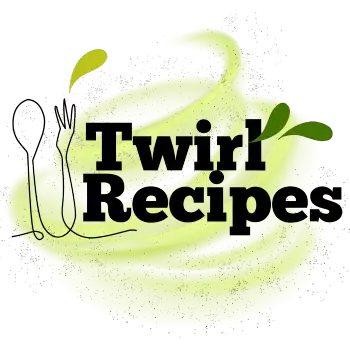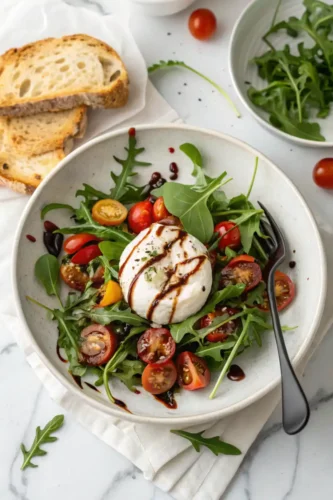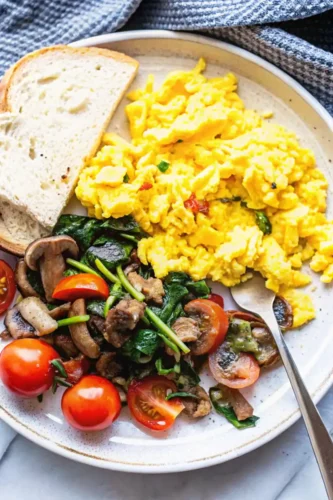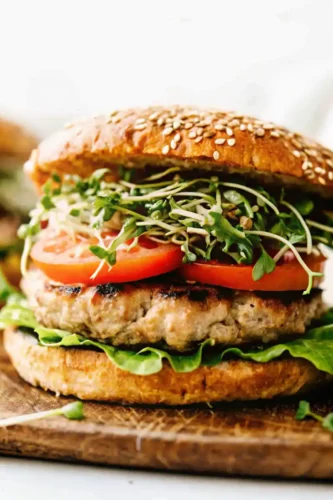Who says comfort food can’t be healthy and inclusive? Meatballs are a timeless favorite, but if you’re on a gluten-free journey, you might think you have to skip out on this classic. Not anymore! With the right ingredients and techniques, you can make gluten–free meatballs that are tender, flavorful, and absolutely irresistible. Let’s dive into why this dish should be your next go-to recipe!
JUMP TO
Why Gluten-Free Meatballs Are the Ultimate Comfort Food
Inclusive for All Diets
One of the best things about gluten free meatballs is their inclusivity. Whether you’re avoiding gluten for health reasons or simply experimenting with new recipes, these meatballs cater to everyone at the table. They pair perfectly with sides like gluten-free bagels or even garlic parmesan chicken pasta. Who wouldn’t love a versatile dish like that?
Packed with Flavor
Don’t believe the myth that gluten-free means flavorless! These meatballs burst with savory spices, garlic, and fresh herbs. Plus, with quality ground turkey or beef, every bite stays juicy and satisfying.
Health Benefits of Gluten-Free Meatballs
Easy on the Digestive System
Opting for a gluten-free diet can work wonders for your digestive system, particularly if you’re sensitive to gluten or have celiac disease. After all, traditional meatballs often rely on breadcrumbs, which may cause bloating or discomfort for those avoiding gluten. Fortunately, by substituting with alternatives like almond flour or certified gluten-free breadcrumbs, you can indulge in your favorite meatball recipes without a second thought. Plus, your stomach will undoubtedly thank you for the effort! Why compromise when going gluten-free can be this simple and satisfying?
Nutritional Value
Gluten-free doesn’t mean you miss out on nutrients. In fact, these gluten free meatballs are packed with protein and essential vitamins, making them a hearty option for lunch, dinner, or even meal prep. Pair them with a side of sourdough breakfast recipes or a fresh salad for a balanced and nourishing meal.
Key Ingredients for Gluten-Free Meatballs
Creating delicious gluten free meatballs is simpler than you might think, thanks to a few smart ingredient swaps and flavorful additions. Here’s a detailed list to guide you:
- Ground Meat (1 lb): Use your favorite protein, such as ground beef, turkey, chicken, or even pork. For a leaner option, turkey is excellent, while beef adds richness to the flavor.
- Gluten-Free Breadcrumbs (½ cup): Opt for certified gluten-free breadcrumbs or substitutes like almond flour, crushed rice crackers, or oat flour to hold the meatballs together.
- Eggs (1 large): Essential for binding the ingredients and ensuring the meatballs maintain their shape.
- Minced Garlic (2 cloves): Adds a bold and aromatic flavor that pairs perfectly with the herbs.
- Finely Chopped Onion (½ medium): Brings a subtle sweetness and depth to the meatballs.
- Fresh Parsley (2 tablespoons, chopped): Infuses the meatballs with a burst of freshness and earthy flavor.
- Grated Parmesan Cheese (¼ cup, optional): For added richness. Use a dairy-free alternative if needed.
- Salt (1 teaspoon): Enhances the natural flavors of the ingredients.
- Black Pepper (½ teaspoon): Provides a gentle kick without overpowering other flavors.
- Paprika (½ teaspoon): Adds a smoky warmth. Optional but highly recommended.
- Milk or Dairy-Free Alternative (2 tablespoons): Helps to moisten the mixture, preventing dry meatballs.
- Italian Seasoning (1 teaspoon): A blend of herbs like basil, oregano, and thyme that elevates the overall taste.
- Worcestershire Sauce (1 teaspoon, optional): Adds umami for an extra depth of flavor. Ensure it’s gluten-free.
How to Make Gluten-Free Meatballs
Now that you’ve gathered your ingredients, let’s dive into the step-by-step process for making perfectly tender and flavorful gluten free meatballs. Whether you’re baking, frying, or air-frying them, these instructions ensure success every time!
Preparation and Mixing
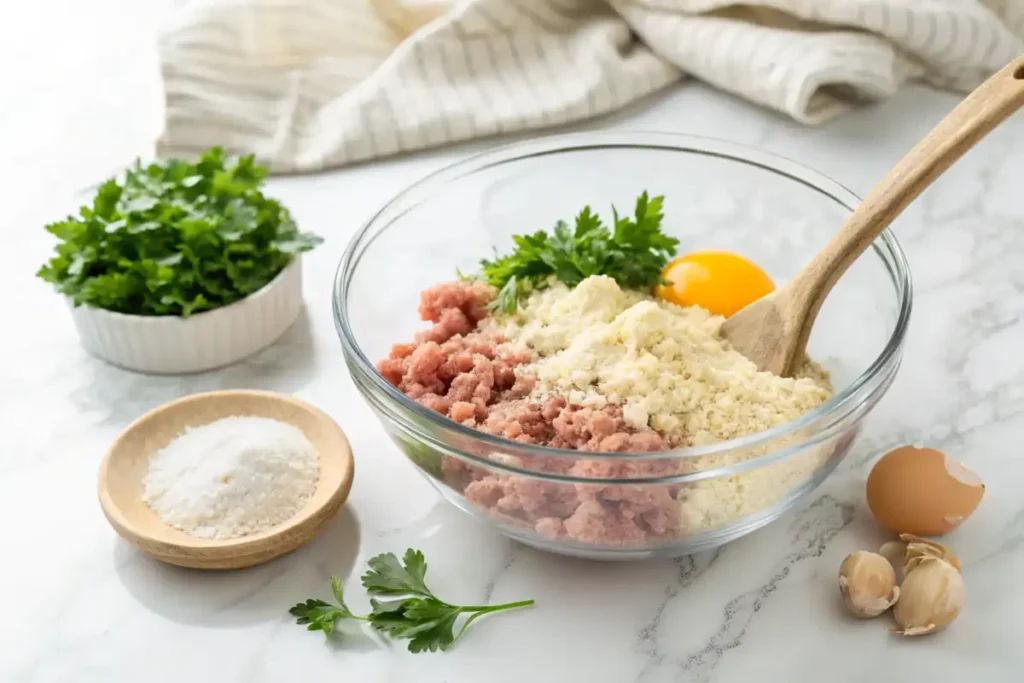
- Prepare the Ingredients:
- Mince the garlic, finely chop the onion, and chop the fresh parsley. Grate the Parmesan if you’re using it.
- Combine the Ingredients:
- In a large mixing bowl, add the ground meat, gluten-free breadcrumbs, egg, minced garlic, chopped onion, parsley, Parmesan (if using), salt, pepper, paprika, and Italian seasoning.
- Mix Gently:
- Use clean hands or a spatula to mix the ingredients just until combined. Overmixing can make the meatballs dense. Aim for a uniform mixture without compressing it too much.
- Add Moisture:
- Pour in the milk or dairy-free alternative and mix lightly. This step keeps the meatballs juicy and tender.
- Shape the Meatballs:
- Scoop out about 1-2 tablespoons of the mixture and roll it into balls. Place them on a plate or baking sheet lined with parchment paper. Aim for uniform sizes to ensure even cooking.
Cooking Methods
Baking:
- Preheat the oven to 400°F (200°C).
- Arrange the meatballs on a parchment-lined baking sheet, leaving some space between them.
- Bake for 18-20 minutes or until they reach an internal temperature of 165°F (74°C). Turn halfway for even browning.
Frying:
- Heat 2-3 tablespoons of olive oil in a skillet over medium heat.
- Add the meatballs in batches, ensuring they don’t overcrowd the pan.
- Cook for 6-8 minutes, turning occasionally, until browned on all sides and cooked through.
Air Frying:
- Preheat the air fryer to 375°F (190°C).
- Lightly coat the meatballs with cooking spray and arrange them in a single layer in the basket.
- Cook for 10-12 minutes, shaking the basket halfway through.
Sauce Pairings
The right sauce can elevate your gluten free meatballs to the next level. Here are a few ideas:
- Classic Marinara: Serve over gluten-free spaghetti for an Italian-inspired meal.
- Creamy Garlic Sauce: Pairs wonderfully with meatballs for a rich, indulgent option.
- Tangy BBQ Sauce: Perfect for appetizers or sliders.
Tips and Tricks for Perfect Gluten-Free Meatballs
Making gluten free meatballs that are tender, flavorful, and perfectly cooked takes a little finesse. Here are some expert tips to ensure every batch is a success.
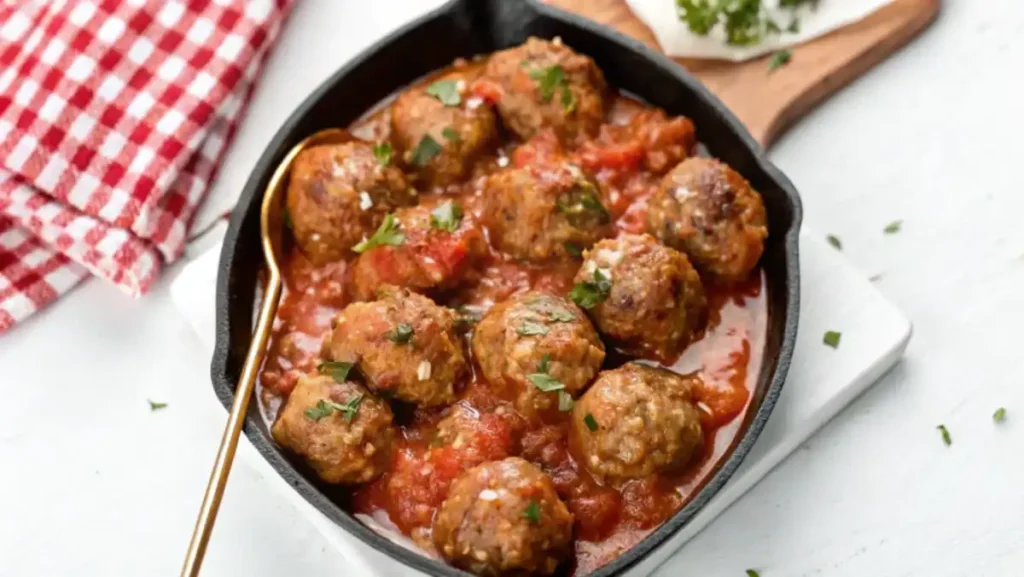
Avoiding Crumbles
- Choose the Right Binders: Gluten-free breadcrumbs or almond flour work best to hold the mixture together. Avoid skipping the egg, as it acts as the glue for the ingredients.
- Mix Gently: Overmixing can lead to tough meatballs. Combine the ingredients just until they hold together, and no more.
Keeping Them Moist and Juicy
- Add Milk or a Dairy-Free Substitute: This step is crucial for locking in moisture. Dry meatballs? Not on our watch!
- Don’t Overcook: Use a meat thermometer to ensure the internal temperature reaches 165°F (74°C), but no higher. Overcooking dries them out.
Enhancing Flavor
- Let the Mixture Rest: Allowing the meatball mixture to sit for 10-15 minutes before shaping helps the flavors meld and makes the meat easier to work with.
- Experiment with Seasonings: Don’t be afraid to customize with your favorite spices like cumin, chili powder, or even a pinch of nutmeg for depth.
Achieving the Perfect Shape
- Uniform Sizes: Use a cookie scoop to portion out the meat mixture. This ensures all meatballs cook evenly, avoiding some being overcooked while others are underdone.
- Light Hands: Roll gently to form smooth, round meatballs without compacting them.
Extra Pro Tips
- Test a Small Batch: Cook a single meatball first to adjust seasonings if needed.
- Double the Recipe: These freeze beautifully, so make extra and save time later.
- Pair Wisely: For a creative pairing, serve with gluten-free bagels as sliders or alongside garlic parmesan chicken pasta for a filling meal.
Storing and Freezing Gluten-Free Meatballs
When you’ve put effort into making a batch of gluten free meatballs, you’ll want to store them properly to maintain their flavor and texture. Whether you’re meal-prepping for the week or saving leftovers, these tips will keep your meatballs fresh and delicious.
Best Practices for Refrigeration
- Cool Before Storing: Allow the meatballs to cool to room temperature before placing them in the fridge. This prevents condensation from forming and keeps them fresher.
- Use Airtight Containers: Store the meatballs in a sealed container or resealable bag. This locks in freshness and prevents them from absorbing other odors in the fridge.
- Shelf Life: Properly stored, cooked meatballs can last up to 3-4 days in the refrigerator.
Freezing Instructions
If you want to save your gluten free meatballs for a later date, freezing is the way to go. Here’s how:
- Flash Freeze:
- Arrange cooked or uncooked meatballs on a baking sheet in a single layer, ensuring they don’t touch.
- Freeze for 1-2 hours or until firm. This prevents them from sticking together.
- Transfer to Freezer Bags:
- Place the frozen meatballs into a freezer-safe bag or container. Be sure to label it with the date.
- Remove as much air as possible to avoid freezer burn.
- Storage Time:
- Frozen meatballs stay good for up to 3 months.
Reheating Tips
- For Refrigerated Meatballs:
- Heat them in the microwave or simmer them in sauce over medium heat until warmed through.
- For Frozen Meatballs:
- Reheat directly from frozen by baking at 350°F (175°C) for 15-20 minutes or simmering in sauce.
Serving Ideas and Variations for Gluten-Free Meatballs
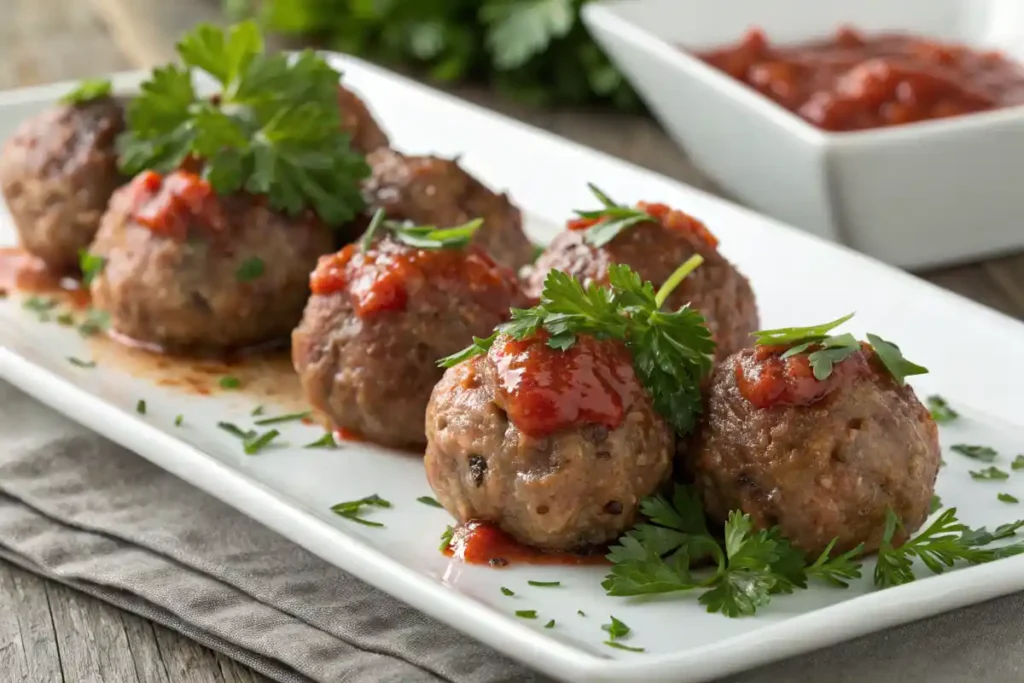
Gluten free meatballs are incredibly versatile, making them the perfect addition to any meal. Whether you’re looking for a classic dinner, a quick snack, or an impressive appetizer, these ideas and variations will keep your meals exciting and delicious.
Classic Serving Ideas
- Gluten-Free Spaghetti and Meatballs
To start, pair your meatballs with a warm bowl of gluten-free spaghetti and marinara sauce for a timeless Italian favorite. Additionally, you can elevate the dish by adding a sprinkle of fresh basil or grated Parmesan. Not only does this add flavor, but it also creates the perfect finishing touch to impress your guests.
- Meatball Subs
For a hearty option, serve your meatballs in a toasted gluten-free bun, topped with melted mozzarella and a generous helping of marinara sauce. Furthermore, these subs are an absolute crowd-pleaser and work well for quick dinners or casual gatherings.
- Appetizers with Dipping Sauces
Lastly, turn your meatballs into irresistible finger foods by serving them with toothpicks and a selection of dipping sauces. For example, barbecue sauce, honey mustard, or even a creamy garlic dip all work wonderfully. This way, your guests have a variety of options to choose from, ensuring there’s something for everyone.
Creative Variations
- Swedish Meatballs
- Swap out marinara for a creamy gluten-free gravy. Serve over mashed potatoes or alongside a side of buttercup squash recipes for a unique twist.
- Meatball Casserole
- Layer your meatballs with marinara, shredded cheese, and cooked gluten-free pasta in a baking dish. Bake until bubbly for a cozy, comforting meal.
- Asian-Inspired Meatballs
- Glaze your meatballs with a homemade soy-free teriyaki sauce and serve over steamed rice or in lettuce wraps for a lighter option.
Quick Snacks and Lunches
- Meal Prep Bowls
- Combine your meatballs with roasted vegetables, quinoa, or rice for an easy, balanced meal prep option. These are great for grabbing on busy days.
- Skewers for Parties
- Thread your meatballs onto skewers with cherry tomatoes, mozzarella balls, and basil leaves for a fresh and vibrant appetizer.
FAQs About Gluten-Free Meatballs
What is a gluten-free alternative to breadcrumbs in meatballs?
Great options include almond flour, crushed rice crackers, or gluten-free oats. Looking for more suggestions? Read the full article here.
What is a gluten-free substitute for panko bread crumbs?
For a lighter, crispier texture that mimics panko breadcrumbs, try these gluten-free alternatives:
– Rice Cereal (Crushed): Provides a similar airy crunch to panko.
– Corn Flakes (Crushed): Gluten-free corn flakes work wonderfully for breading or in meatballs.
– Coconut Flour: Adds a mild sweetness and works well in small amounts.
– Quinoa Flakes: Great for binding and texture, especially in meatballs.
Choose a substitute based on your desired flavor profile and texture.
What do breadcrumbs do in meatballs?
Breadcrumbs play an essential role in meatballs by:
– Binding the Ingredients: They help hold the meat mixture together, ensuring the meatballs don’t fall apart during cooking.
– Adding Moisture: Breadcrumbs soak up milk or other liquids, which keeps the meatballs juicy.
– Improving Texture: They prevent the meat from becoming too dense by creating a light, tender bite.
When making gluten free meatballs, it’s important to use an alternative that achieves these same effects without the gluten.
Latest Recipes to Inspire Your Next Meal
